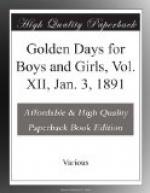“The only working tools required are sharp scissors and a razor, some very thick, strong gum arabic, a little water and a duster, in case of fingers becoming sticky.
“Each page is to receive the feathers of only one bird; then they are sure to harmonize, however you may combine them.
“A common wood-pigeon is an easy bird to begin with, and readily obtained at any poulterer’s. Draw out the tail feathers and place them quite flat in some paper till required. Do the same with the right wing and the left, keeping each separate and putting a mark on the papers that you may know which each contains.
“The back, the breast, the fluffy feathers beneath, all should be neatly folded in paper and marked; and this can be done in the evening or at odd times, but placing the feathers on the pages ought to be daylight work, that the colors may be studied. Now open the tail-feather packet, and with the razor carefully pare away the quill at the back of each feather.
“This requires much practice, but at last it is quickly done, and only the soft web is left, which will be perfectly flat when gummed upon the page. When all the packets are thus prepared (it is only the quill feathers that require the razor) then we may begin.
“I will describe a specimen page, but the arrangement can be varied endlessly, and therein lies one of the charms of the work. One never does two pages alike—there is such scope for taste and ingenuity—and it becomes at last a most fascinating occupation.
“Toward the top of the page, place a thin streak of gum, lay upon it a tail feather (the quill end downward), and put one on either side. The best feathers of one wing may be put down, one after the other, till one has sufficiently covered the page; then the other wing feathers may be placed down the other side; the centre may be filled in with the fluffy feathers, and the bottom can be finished off with some breast feathers neatly placed so as to cover all quill ends.
“When one works with small plumage, a wreath looks very pretty, or a curved spray beginning at the top with the very smallest feathers and gradually increasing in size to the bottom of the page.
“Butterflies or moths made of tiny feathers add much to the effect, and they are made thus. It is best, I find, to fill a wide-mouthed bottle with dry gum, and just cover the gum with the water, allow it to melt, keep stirring and adding a few drops of water till just right—no bought liquid gum equals one’s own preparation.
“To make the book complete, there should be a careful water-color study of the bird on the opposite page, its Latin and English name, and a drawing of the egg. It may interest some to know how I obtained the ninety-one birds which fill my books. Some were the dried skins of foreign birds, either given me by kind friends or purchased at bird-stuffers’. The woodpecker and nut-hatch were picked up dead in the garden. The dove and budgerigars were moulted feathers saved up until there were sufficient to make a page.




